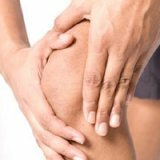Physiotherapy with a meniscus

One of the most common types of musculoskeletal injuries is problems with the knee joint meniscus. Therapy of such damages can be carried out both operatively and conservatively. However, in that, and in another case, an important component of effective treatment is therapeutic exercise with meniscus lesions.
It includes the following exercises:
Active exercises on the knee joint with the assistance of , i.e. The patient helps the movements of one leg with the help of the second. Usually, he sits so that his legs do not touch the floor. A healthy leg supports the patient, flexes and straightens it. The amplitude of such swings should be as much as possible. You have to bend your leg as slowly as possible, counteracting the force of gravity and gently securing the movement with a healthy foot.
Step-exercises, accompanied by visual control. First, a low step is used, not more than ten centimeters high. The patient stands on the step in the starting position. Then he slowly steps forward with a healthy foot, that is, the weight of the body is all on the aching leg, which will help the patient to train the balance. A mirror is placed in front of the patient - to monitor the movement of the body, behind its location, so that at a step from the step the patient does not fall over to the side where the diseased leg is located. Then the patient returns to the starting position and repeats the exercise anew. Gradually, as you master the exercise, the height of the step increases.
Active flexion with maximum amplitude in the knee joint with assisting. The assistant in this case means that the patient during the exercise helps the bending injured leg with the help of healthy, and most flexion - with the help of the entire body weight. With this exercise, the patient becomes a healthy foot on the floor, and the damaged one puts on a height of up to forty centimeters. After that, he leans forward, so that the aching leg is maximally bent at the knee. After reaching this position, the patient should remain in it for about ten seconds, and then he returns to the starting position and repeats the exercise anew.
Performing jumps on one leg. On the floor, draw a long straight line, along which the patient should make the longest possible jumps on one leg, trying each time to fall on different sides of the line. This type of exercise trains the strength of the muscles of the thighs, a sense of balance and improves the coordination of movements. Simultaneously, this exercise serves as a kind of test - by how far the patient jumps, one can judge how successful the rehabilitation program is. Plyometric jumps to the elevation. First put a step-height of ten centimeters. The patient becomes in front of him( the starting position), then makes a jump with both feet, jumping on the step. In doing so, he must try to make the leap soft, and land so that the load falls on both legs. Gradually, the height of the steppe increases, as the patient is rehabilitated.
Lateral plyometric jumps. In this exercise, as in the previous step, the step is first set. The patient becomes to the side of it( the starting position).Then he jumps sideways to the step, and continuing to move, jumps off the other side, trying to jump gently, distributing his weight on both feet evenly. Step height increases as the patient is rehabilitated.
Underwater walking on the treadmill. If the postoperative wound is completely closed and there is no chance of infection, then it is possible to walk on an underwater treadmill. This exercise is good because it helps to restore a normal campaign with a reduced( due to immersion under water) body weight. When walking on an underwater treadmill, if the body is submerged in the water around the neck, the axial load on the injured limb decreases by more than half( 60-80%), and if the body is submerged only to the belt level, then by 30-40%.
It should be remembered that self-rehabilitation is fraught with deterioration of the leg. Therapeutic exercise should be performed only after consultation with the treating specialist.



